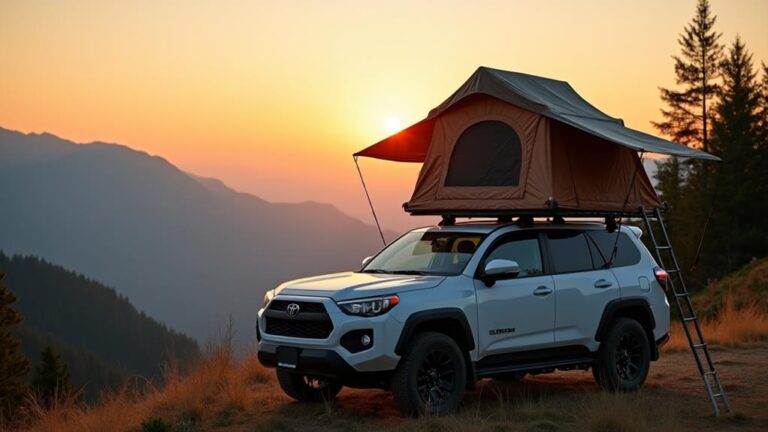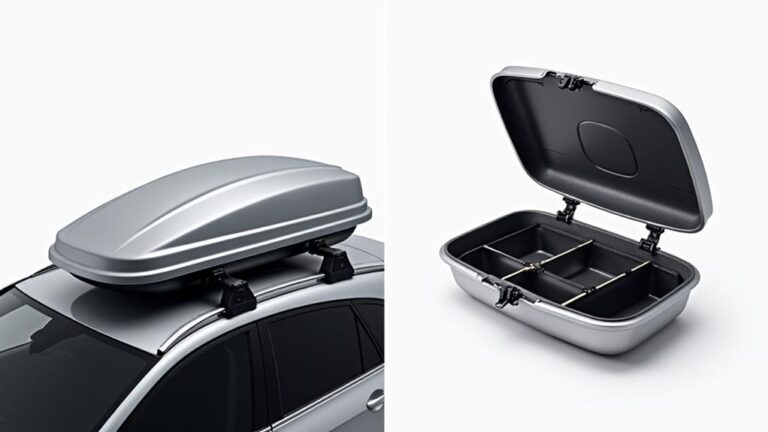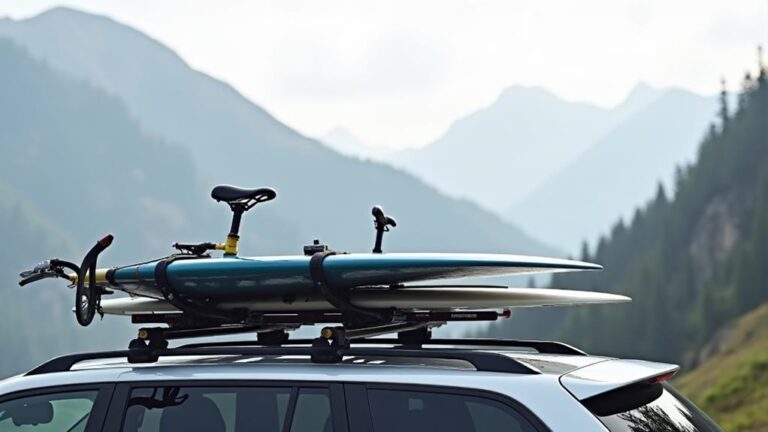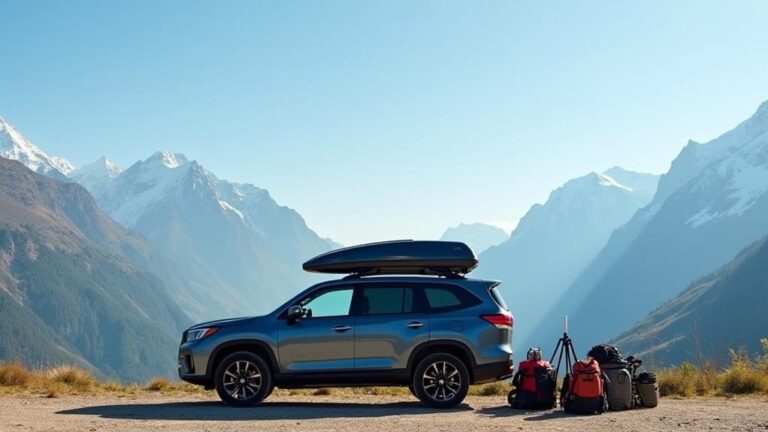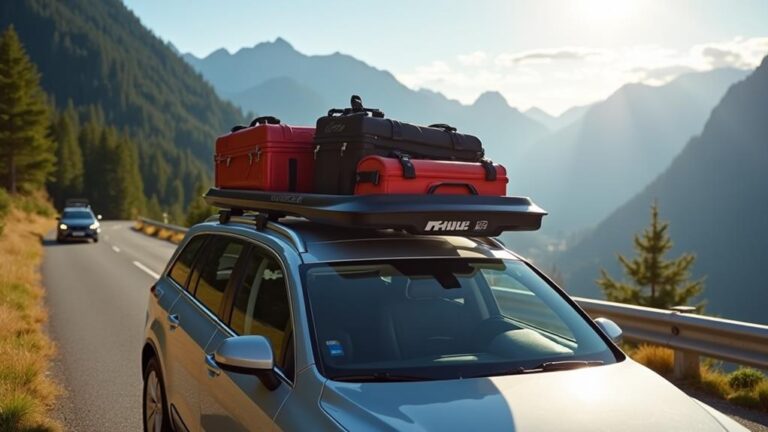You're deciding whether to invest in a roof top tent, and you're considering your car's capabilities, but you're also weighing the potential risks. Adding a roof top tent can be a great way to enhance your camping experience, but only if your car can support the added weight. The critical question is: can your vehicle handle the load? To find out, you'll need to assess your roof's strength and the tent's weight. But what exactly are you looking for, and how do you calculate the weight limits? The answer to these questions will make all the difference in ensuring a safe and enjoyable adventure.
Key Takeaways
- Check your vehicle's owner's manual for roof load capacity limits and specific requirements for roof top tents.
- Inspect the roof for signs of damage or wear that could compromise its strength and capacity.
- Calculate the combined weight of the roof top tent, its mounting system, and any additional gear or occupants.
- Ensure the weight distribution of the roof top tent is even to prevent excessive stress on the vehicle's roof.
- Consider consulting the manufacturer or a dealership for guidance on determining compatibility with a roof top tent.
Assessing Your Vehicle's Roof Strength
When it comes to installing a roof top tent, your vehicle's roof strength is a critical factor to consider.
You'll want to assess whether your vehicle's roof can support the weight of a roof top tent, taking into account its roof durability and potential need for roof reinforcement.
Start by consulting your vehicle's manufacturer manual or contacting the manufacturer directly to determine the maximum roof load capacity.
This information is usually provided in pounds or kilograms per square meter.
You'll also want to check if your vehicle's roof has any existing reinforcement, such as roof rails or crossbars, which can increase its load-bearing capacity.
Next, inspect your vehicle's roof for any signs of damage or wear that could compromise its strength.
Check for dents, rust, or other damage that could weaken the roof's structural integrity.
If you find any damage, it may be necessary to repair or replace the roof before installing a roof top tent.
Additionally, consider adding roof reinforcement, such as a roof rack or roof bars, to increase your vehicle's roof durability and support the weight of the tent.
Understanding Roof Top Tent Weights
The weight of a roof top tent is a crucial factor in determining its compatibility with your vehicle, and it's essential to understand the different components that contribute to the overall weight.
The shell of the tent, typically made from waterproof materials such as polyester or nylon, is the main contributor to its weight.
Other components like the ladder, mattresses, and poles also add to the overall weight.
Tent Materials play a significant role in determining the weight of the roof top tent.
For instance, hard-shell tents made from fiberglass or aluminum are generally heavier than soft-shell tents made from fabric.
The type and quality of the tent's fabric, frame, and other materials also impact its weight.
The Weight Distribution of the tent is also crucial.
A well-designed tent should distribute its weight evenly to prevent any uneven stress on your vehicle's roof.
Look for tents with a low center of gravity and a wide base to ensure stability and even weight distribution.
Understanding these factors will help you choose a roof top tent that's compatible with your vehicle and safe to use.
Measuring Your Vehicle's Roof Size
Measuring Your Vehicle's Roof Size
You've determined the weight of your roof top tent, now it's time to ensure it fits your vehicle's roof.
To do this, you'll need to take precise measurements of your vehicle's roof dimensions. This will help you determine if your roof top tent will fit comfortably and securely.
To take accurate measurements, you'll need a few essential tools:
- Tape measure: A flexible tape measure will allow you to easily measure curved or irregular roof shapes.
- Ladder or step stool: A sturdy ladder or step stool will give you safe access to your vehicle's roof.
- Calculator: A calculator will help you quickly calculate the overall size of your roof top tent and compare it to your vehicle's roof dimensions.
When taking measurements, make sure to record the length, width, and any obstructions such as roof rails, antennas, or skylights.
These measurements will help you determine the best position for your roof top tent and ensure a secure fit.
Vehicle Roof Load Capacity Limits
When choosing a roof top tent, you must consider your vehicle's roof load capacity limits to ensure safe installation and use.
You need to understand the weight limits of your vehicle's roof, as exceeding them can lead to structural damage or even roof collapse.
To calculate load capacity, you'll need to assess the combined weight of the roof top tent, its mounting system, and any additional gear or occupants.
Weight Limits Explained
As you're shopping for a rooftop tent, it's essential to consider the weight limits of your vehicle's roof to ensure safe and secure installation.
Your vehicle's roof load capacity limits are determined by the manufacturer based on various factors, including the type of materials used, roof design, and structural integrity.
To determine the weight limits of your vehicle's roof, you'll need to consult your owner's manual or contact the manufacturer.
It's also crucial to conduct a vehicle inspection to identify any potential issues that may affect the roof's load capacity.
Roof strength testing is another critical factor in determining the weight limits of your vehicle's roof.
- Gross Vehicle Weight Rating (GVWR): The maximum weight of your vehicle, including passengers, cargo, and the roof load.
- Roof Rack Load Capacity: The maximum weight that your roof rack can support, which may be lower than the vehicle's roof load capacity.
- Static Load Test: A test that evaluates the roof's ability to support a stationary load, ensuring it can handle the weight of a rooftop tent.
Calculating Load Capacity
Calculating the load capacity of your vehicle's roof involves factoring in several key components.
You'll need to consider the Gross Vehicle Weight Rating (GVWR), the curb weight, and the roof rack's weight capacity. Start by consulting your owner's manual for the GVWR and curb weight.
Then, determine the weight of the roof rack, including all crossbars, mounts, and hardware.
Next, calculate the roof math. Subtract the curb weight from the GVWR to find the available payload capacity.
This is the maximum weight your vehicle can safely carry, including passengers, cargo, and the roof rack.
Now, apply load factors, which account for the weight distribution and balance of the roof rack.
A common load factor is 1.5, meaning the weight of the roof rack and cargo shouldn't exceed 2/3 of the available payload capacity.
For example, if your vehicle has a GVWR of 5,000 pounds and a curb weight of 3,500 pounds, the available payload capacity is 1,500 pounds.
Applying a load factor of 1.5, the maximum weight of the roof rack and cargo shouldn't exceed 1,000 pounds.
Factors Affecting Roof Top Tent Weight
Determining the right roof top tent for your vehicle requires careful consideration of several key factors, and one crucial aspect to consider is weight.
When evaluating the weight of a roof top tent, you'll need to think about the materials it's made of, as well as how it's constructed. Different materials have varying weights, which can significantly impact the overall weight of the tent.
Some common tent materials include fabric, aluminum, and fiberglass. Fabric tents are generally the lightest, while fiberglass tents are often the heaviest.
- Tent Materials: The type of materials used for the tent's fabric, frame, and other components can greatly affect its weight. Heavier materials like fiberglass and wood will add more weight to the tent.
- Load Calculations: You'll need to consider the maximum weight the tent is designed to hold, as well as the weight of any additional features, such as built-in mattresses or storage compartments.
- Frame and Pole Design: The design and construction of the tent's frame and poles can also impact its weight. A more complex design with multiple poles may be heavier than a simpler design with fewer poles.
Roof Top Tent Mounting Options
When selecting a roof top tent mounting option, you'll typically encounter three primary choices:
Clamp Mount Systems are versatile and can be installed on various vehicle types, while Track Mount Options offer flexibility and customization.
Permanent Roof Rails, on the other hand, provide a secure and permanent installation solution.
Clamp Mount Systems
Your roof top tent's mounting system can make or break its overall functionality and safety.
Clamp mount systems are one popular option for securing your roof top tent. This type of mounting system uses clamps to attach to your vehicle's roof rails or bars, providing a sturdy base for your tent.
When choosing a clamp mount system, consider the following factors to ensure tent security and clamp durability:
- Weight capacity: Ensure the clamp mount system's weight capacity exceeds your roof top tent's weight to prevent collapse or detachment.
- Material quality: Opt for clamp mount systems made from high-quality, corrosion-resistant materials to withstand harsh weather conditions.
- Adjustability: Select a clamp mount system with adjustable clamps to accommodate different roof rail sizes and ensure a secure fit.
A well-designed clamp mount system can provide a safe and secure base for your roof top tent.
However, it's essential to carefully evaluate the system's specifications and features to ensure it meets your needs and provides optimal tent security and clamp durability.
Track Mount Options
If you've evaluated clamp mount systems and found them not suitable for your needs, track mount options offer an alternative solution for securing your roof top tent.
Track systems are versatile mounting options that allow for the attachment of various accessories, including roof top tents. These systems typically consist of a series of tracks or channels that are installed on your vehicle's roof, providing a solid foundation for mounting your roof top tent.
Track mount options provide greater flexibility and adjustability compared to clamp mount systems.
They enable you to position your roof top tent in various locations along the track, allowing for optimal placement and easy access. Track systems also offer a higher weight capacity, making them suitable for larger roof top tents or for vehicles that require additional support.
When selecting a track mount option, consider the type of track system that suits your vehicle's roof type and the weight of your roof top tent.
Ensure that the track system is compatible with your roof top tent's mounting hardware and that it meets your vehicle's weight capacity requirements.
Permanent Roof Rails
Permanent roof rails offer a sturdy and reliable solution for mounting roof top tents, providing a solid foundation for securing your gear.
They're designed to be permanently attached to your vehicle, providing a fixed point for installing roof top tents. This mounting option is ideal for frequent users who want a hassle-free installation process.
When choosing permanent roof rails, consider the following:
- Weight capacity: Ensure the rails can support the combined weight of the roof top tent, occupants, and gear.
- Rail material: Rails can be made from aluminum, steel, or fiberglass. Choose a material that suits your needs and vehicle type.
- Installation requirements: Consider the installation process, including the tools and expertise required, as well as any modifications needed to your vehicle.
Proper rail installation is crucial to ensure the safety and security of your roof top tent.
Regular rail maintenance is also essential to prevent damage and wear.
Check your rails regularly for signs of rust, corrosion, or damage, and perform repairs or replacements as needed.
Vehicle Make and Model Considerations
Choosing the right roof top tent involves considering the specifications of your vehicle, particularly its make and model.
Vehicle history plays a significant role in determining the compatibility of a roof top tent with your car. Check the manufacturer's website or consult with a dealership to gather information about your vehicle's roof load capacity and any specific requirements for roof top tents.
Manufacturer guidance is essential in this process.
Review your vehicle's owner's manual and look for any sections that discuss roof top tents or roof loads.
Some manufacturers may have specific recommendations or restrictions for roof top tents, so it's crucial to follow their guidelines.
Additionally, check if your vehicle has any certifications, such as a roof load capacity rating, that can help you determine its suitability for a roof top tent.
Roof Rack Compatibility Requirements
When selecting a roof top tent, you'll need to consider the compatibility requirements of your vehicle's roof rack to ensure a safe and secure installation.
This involves checking the load capacity limits of your roof rack to ensure it can handle the weight of the tent and occupants.
Additionally, consider the crossbar spacing requirements and mounting style options to ensure a proper fit for your roof top tent.
Load Capacity Limits
Considering your vehicle's roof rack system is meant to bear the weight of your gear, it's essential to pay close attention to the load capacity limits before installing a roof top tent.
Exceeding these limits can lead to structural damage, compromised safety, and potentially catastrophic consequences.
To determine the load capacity of your roof rack system, you should consult your vehicle's owner's manual or contact the manufacturer.
Additionally, you may want to conduct a vehicle inspection to assess the condition and durability of your roof rack.
Some manufacturers also perform roof strength tests to evaluate the load-bearing capacity of their vehicles.
When evaluating the load capacity limits of your roof rack system, consider the following:
- Total weight limit: The maximum weight your roof rack system can support, including the roof top tent, occupants, and gear.
- Dynamic weight limit: The maximum weight your roof rack system can support while the vehicle is in motion.
- Static weight limit: The maximum weight your roof rack system can support when the vehicle is stationary.
Crossbar Spacing Requirements
Your vehicle's roof rack system has a specific load capacity, and now it's time to assess its compatibility with a roof top tent.
One crucial factor to consider is the crossbar spacing requirements. This refers to the distance between the crossbars on your roof rack, which can affect the fit and stability of your roof top tent.
To ensure a proper fit, check the manufacturer's recommendations for crossbar spacing. Most roof top tents require a minimum crossbar spacing of 24-30 inches, but this can vary depending on the specific model.
It's essential to ensure that the crossbars are spaced close enough to provide adequate support for the tent's weight and to allow for proper tent clearance.
Additionally, consider the bar flexibility of your roof rack system.
If the crossbars are too flexible, they may not provide a stable platform for the tent, which can compromise its performance and safety.
Look for a roof rack system with sturdy crossbars that can support the weight of the tent and its occupants.
Mounting Style Options
The roof top tent you've chosen must be compatible with your vehicle's roof rack system, so it's time to explore the mounting style options.
Ensuring a secure and proper fit is crucial to avoid any damage to your vehicle or the roof top tent.
You'll need to consider the roof rack's mounting style, as some roof top tents are designed to work with specific rack systems.
When selecting a roof top tent, look for mounting flexibility to ensure it can be easily installed on your vehicle.
Additionally, rooftop clearance is essential, as you'll want to ensure there's enough space to open and close the tent without any obstructions.
When evaluating the mounting style options, consider the following:
- Clamp-on mounting: This style uses clamps to attach the roof top tent to the roof rack's crossbars. It's a popular option, but it may not be suitable for all roof rack systems.
- Channel mounting: This style uses a channel or track system to attach the roof top tent to the roof rack. It provides more flexibility and is often used on roof racks with a more complex design.
- Fixed mounting: This style uses a fixed point or bracket to attach the roof top tent to the roof rack. It's a more permanent solution, but it may limit the roof top tent's adjustability.
Dynamic Vs Static Weight Capacity
When shopping for a roof top tent, it's essential to understand the difference between dynamic and static weight capacity, as this knowledge can be crucial in ensuring your safety while camping. The weight limits of your vehicle's roof will play a significant role in determining the type of roof top tent you can install.
| Weight Capacity Type | Definition | Considerations |
|---|---|---|
| Static | The weight a roof can support when the vehicle is stationary. | Vehicle modifications, such as roof racks, can affect static weight capacity. |
| Dynamic | The weight a roof can support while the vehicle is in motion. | Dynamic weight capacity is typically lower than static weight capacity due to wind resistance and road vibrations. |
| Gross Vehicle Weight | The total weight of the vehicle, including passengers, cargo, and roof top tent. | Exceeding the gross vehicle weight can compromise vehicle safety and stability. |
| Payload Capacity | The maximum weight a vehicle can carry, including passengers and cargo. | Payload capacity should be considered when choosing a roof top tent to avoid overloading the vehicle. |
Understanding the difference between dynamic and static weight capacity will help you choose a roof top tent that's compatible with your vehicle's weight limits, ensuring a safe and enjoyable camping experience. Consider your vehicle's modifications and weight limits when selecting a roof top tent.
Calculating Safe Weight Distribution
Calculating safe weight distribution is crucial to ensure your vehicle's stability and safety while carrying a roof top tent.
When assessing your vehicle's capacity to support a roof top tent, you must consider the weight of the tent, occupants, and other gear.
It's essential to distribute this weight evenly to prevent putting excessive stress on the vehicle's roof, which can compromise its structural integrity.
To calculate safe weight distribution, you'll need to consider the following factors:
- *Roof reinforcement*: Check if your vehicle's roof has been reinforced with additional structural support, such as roof rails or crossbars. This can affect the weight capacity and distribution.
- *Weight of the tent and gear*: Calculate the combined weight of the roof top tent, occupants, and other gear, such as luggage or camping equipment.
- *Vehicle's roof dimensions*: Measure the length and width of your vehicle's roof to determine the optimal placement of the roof top tent and ensure even weight distribution.
Frequently Asked Questions
Can I Use a Rooftop Tent on a Sunroof Vehicle?
You'll need to check the sunroof clearance and roof rack compatibility of your vehicle before installing a rooftop tent, ensuring the rack's weight capacity and clearance don't interfere with the sunroof's opening mechanism.
Will a Rooftop Tent Affect My Car's Mileage?
You're weighing convenience against costs – will a rooftop addition impact your wallet? Yes, it will; a rooftop tent affects fuel efficiency due to increased wind resistance, potentially decreasing your car's mileage by 10-20%.
Are Rooftop Tents Allowed in National Parks?
You'll need to check park rules and campsite regulations before taking your rooftop tent to a national park, as some areas may have specific restrictions or requirements regarding tent size, placement, and installation.
Can I Install a Rooftop Tent on a Leased Vehicle?
You're itching to elevate your adventures, but first, take a peek at your lease agreement. Check if it allows modifications, and review your insurance coverage to ensure a rooftop tent doesn't void it.
Do Rooftop Tents Void My Car's Warranty?
You should review your vehicle's warranty clauses and manufacturer guidelines to determine if installing a rooftop tent voids it. Check for specific exclusions or requirements to avoid potential warranty issues down the line, if any.
Conclusion
Don't let the weight of a roof top tent be the elephant in the room – make sure your car can handle it. Assess your vehicle's roof strength and calculate the combined weight of the tent, mounting system, and gear. Consider factors like roof size, load capacity limits, and dynamic vs static weight. By doing your homework, you'll be on solid ground and ready to hit the road with your roof top tent.
